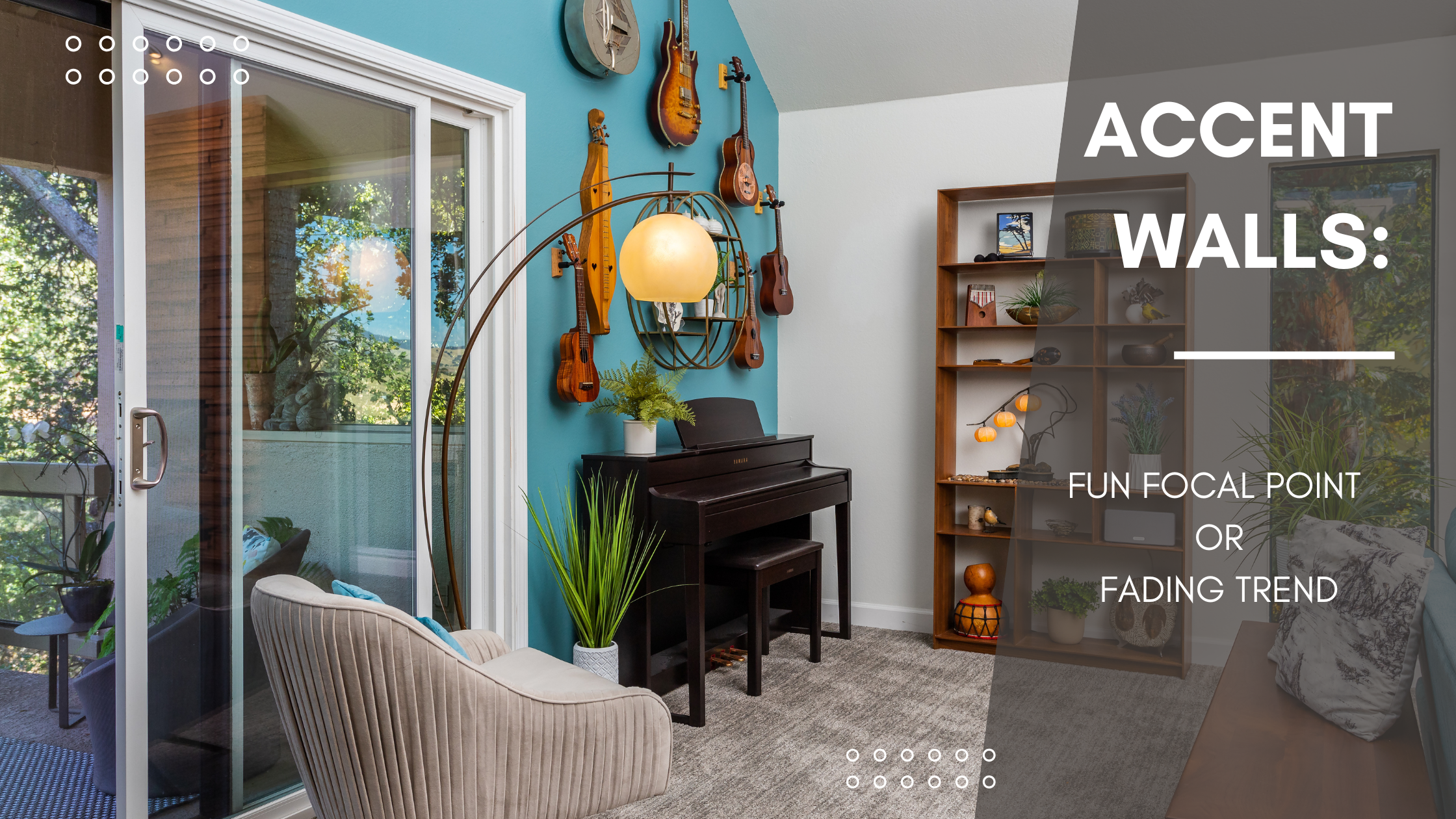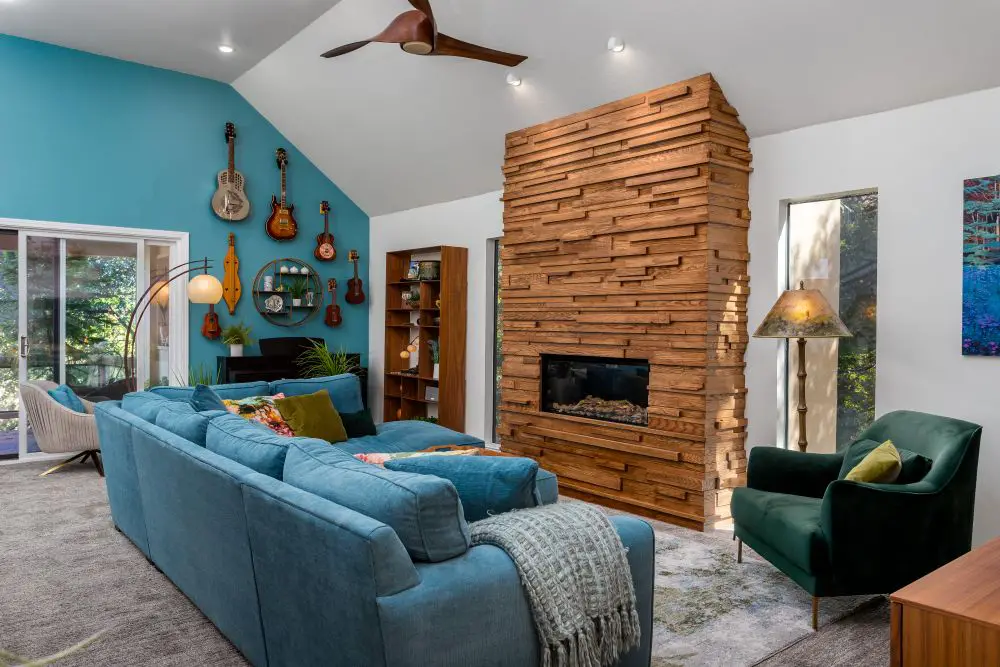By using our website, you agree to the use of cookies as described in our Cookie Policy
The Boss’s Daughter
Accent Walls: Fun Focal Point or Fading Trend?

Accent Walls: Fun Focal Point or Fading Trend?
There was a time when every homeowner wanted the accent wall. Usually red, often glossy, and almost always behind the couch. But like most trends, that look evolved. Today, accent walls aren’t about being loud — they’re about adding depth, texture, and quiet sophistication.
Whether you’re personalizing a Rossmoor condo or opening up a Walnut Creek living space, accent walls can still have a big design payoff — when they’re done intentionally.
Key Takeaways
-
Accent walls are not out; the modern approach uses tone, texture, and materials for a subtle focal point.
-
Best use cases: define zones in open plans, highlight features like fireplaces or built-ins, and add warmth to large rooms.
-
Avoid random placement, clashing bright colors, and ignoring how light changes throughout the day.
-
Current options that work: tone-on-tone paint, wood slats or paneling, tile feature walls, and modern wallpaper or murals.
-
For a bold yet flexible look, paint the lower third of a wall for a modern wainscot effect.
What Is a Modern Accent Wall?
The modern accent wall is all about dimension, not dominance. Instead of one dramatic color, homeowners are turning to texture, sheen, and subtle contrast.
Why It Works
A well-placed accent wall naturally guides the eye. It gives rooms structure in open layouts, adds rhythm to minimalist spaces, and helps large rooms feel cozy.
How to Do It
Choose a wall with purpose — the one that frames your furniture or anchors your favorite feature. Then decide what type of accent fits your style:
-
Tone-on-tone paint: Creates depth using a slightly darker or lighter shade of your wall color. Works beautifully in bedrooms and hallways.
-
Wood slats or paneling: Brings warmth and a custom feel, perfect for Rossmoor bedrooms or entryways.
-
Tile feature walls: Ideal for bathrooms and kitchens where durability meets design.
-
Wallpaper or murals: Adds pattern or personality without needing more décor. Peel-and-stick options make them renter-friendly, too.
When Accent Walls Work A vibrant teal accent wall brings personality and balance to this eclectic living room, proving that a bold backdrop can still feel cozy and curated.
A vibrant teal accent wall brings personality and balance to this eclectic living room, proving that a bold backdrop can still feel cozy and curated.
Accent walls shine when they support how a room is used.
Define Zones in Open Plans
In modern East Bay homes, especially open-concept remodels, color can divide spaces without closing them off. A soft green or greige on a dining nook wall visually separates it from the kitchen, while maintaining flow.
Highlight Architectural Features
Fireplaces, built-ins, and recessed areas deserve attention. A textured wall treatment or darker tone behind them adds instant depth.
Add Warmth to Large Rooms
In oversized living areas, lighter walls can feel flat. Painting one wall in a richer hue visually “pulls in” the space and creates comfort without shrinking it.
Accent Wall Mistakes to Avoid
Accent walls go wrong when they’re done for novelty rather than intention.
Random Placement
Every room has a “visual anchor.” If your accent wall isn’t it, the result feels off-balance. Stand in each corner of the room and see which wall draws your eye first — that’s your natural focal point.
Clashing Colors
Bright or trendy colors can overwhelm. Stick to tones that share undertones with your existing palette — for example, warm beige walls pair best with earthy greens, not icy blues.
Ignoring Light Changes
Color shifts dramatically from morning to evening. Always test paint samples in natural and artificial light before committing. This small step prevents expensive repaints later.
How to Choose an Accent Wall: A Mini Decision Guide
-
Identify the Focal Point: Is it your fireplace, bed, or media wall? That’s your likely candidate.
-
Test Light: Tape color samples and view them morning, midday, and evening.
-
Confirm Palette Harmony: Ensure undertones match flooring and furniture.
-
Select Finish & Sheen: Flat hides flaws, eggshell adds soft sheen, satin offers durability.
-
Add Detail: For subtlety, extend the accent color onto a low ceiling beam or nook.
Pro Tip:
If you want a bold look but get color-commitment anxiety, paint only the lower third of the wall (like modern wainscot). It grounds the room, leaves breathing space above, and can easily be repainted later.
Accent Wall Ideas That Work in the East Bay
At Toupin Construction, we’ve brought dozens of accent walls to life across Rossmoor, Walnut Creek, and beyond. Here are a few of our favorites:
Rossmoor Bedroom Retreat
We installed soft sage paneling behind the bed for one client. The result? Instant calm and a feeling of depth without overpowering their natural-light-filled condo.
Powder Bath Statement
A full wall of vertical tile from floor to ceiling added texture and durability — no paint touch-ups needed. The light bounced off the glossy surface, creating a spa-like feel.
Walnut Creek Living Room
A tone-on-tone gray accent behind the fireplace subtly defined the zone in an open concept without breaking visual flow. It tied perfectly into the new custom cabinetry color.
Each of these projects proves that when an accent wall aligns with layout, light, and purpose, it transforms from trend to timeless design move.
Pro Tips for Getting It Right
-
Start with a neutral palette: Then layer contrast gradually.
-
Mind the transitions: Paint edges cleanly where walls meet ceilings or trim.
-
Consider texture: Flat finishes add calm; semi-gloss highlights architectural detail.
-
Stay consistent with materials: Repeating a finish (like the same wood tone) elsewhere unifies the look.
And remember: the most beautiful accent wall often goes unnoticed at first glance — it simply feels right.
Frequently Asked Questions About Accent Walls
Are accent walls outdated?
No. Accent walls have shifted from loud colors to quiet, refined treatments. Homeowners now use tone-on-tone paint, wood slats, tile, and wallpaper for depth and structure. The style feels current when it supports the room’s layout and palette.
Where do accent walls work best?
They work best where there’s a clear focal point or function. Use them to define a dining area or reading nook in an open plan, frame a fireplace or built-in, or add intimacy to a large room. Choose the wall your eye goes to first and consider how daylight moves across it.
What common mistakes should I avoid with accent walls?
Avoid placing an accent wall without a visual reason, picking bright colors that fight your palette, and skipping light tests. View paint samples at different times of day. Confirm the wall you choose supports the room’s flow and furniture plan.
What materials and finishes are trending for accent walls?
Top picks include tone-on-tone paint for depth, vertical wood slats or paneling for warmth, tile in kitchens and baths for durability, and modern wallpaper or murals for pattern. These options feel fresh and pair well with open layouts and softer palettes.
How can I try bold color without overcommitting?
Paint the lower third of a wall to create a modern wainscot effect. It anchors the room, keeps sightlines calm, and lets you update the top section later with minimal effort.
Final Thoughts
Accent walls are not fading — they’re evolving. They’ve traded bright red drama for a quieter sophistication that feels right at home in today’s East Bay designs. Whether it’s a textured tile wall or a soft color shift, the new accent wall serves your layout, supports your lighting, and enhances your everyday space.
Before you pick up a brush, think about why that wall matters. When purpose drives design, the result always feels timeless.
Ready to Plan Your Perfect Accent Wall?
Let’s make it intentional, not accidental.
Contact Toupin Construction to design a focal point that fits your home’s story.
‹ Back



Comments